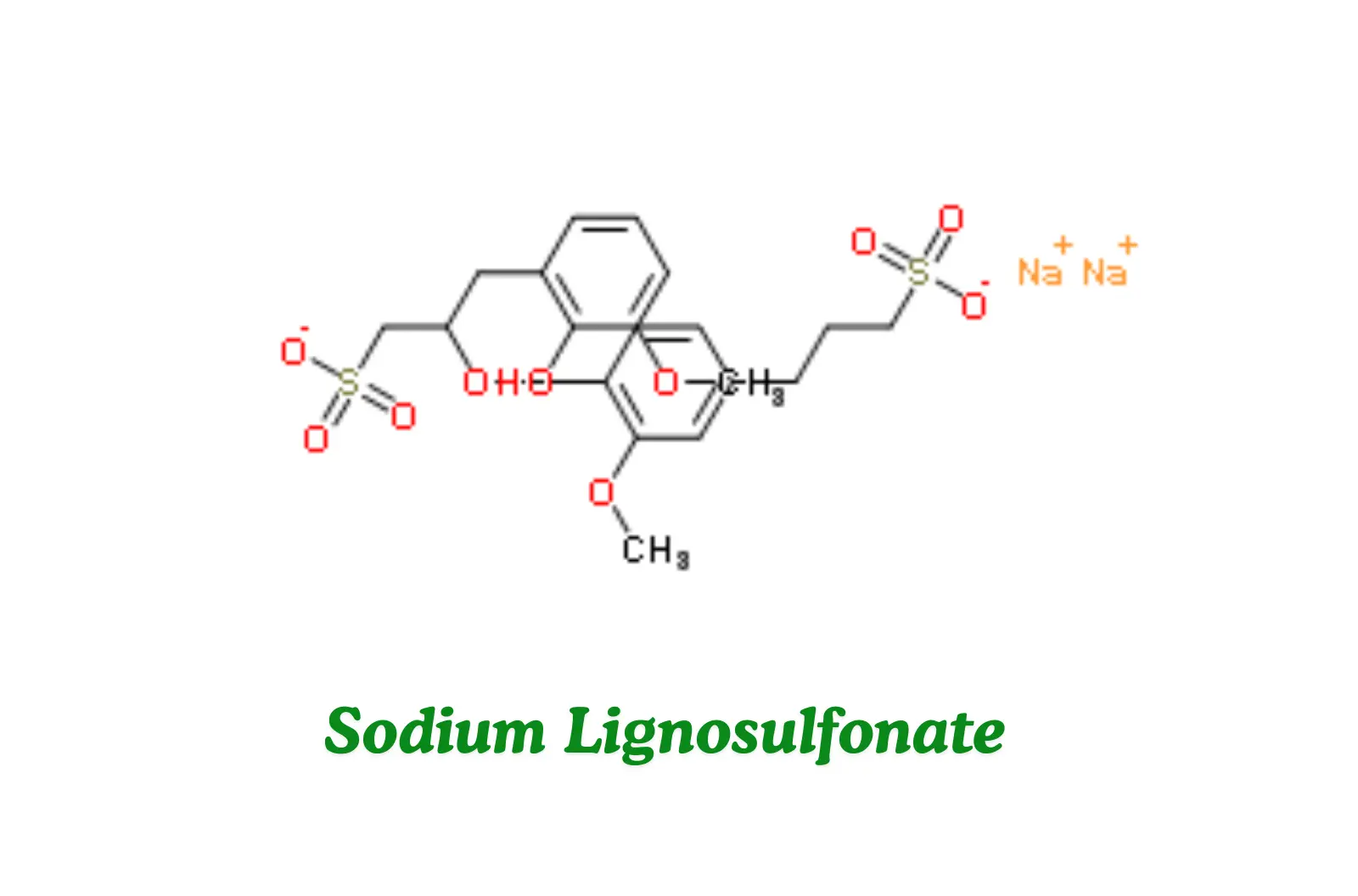The CAS (Chemical Abstracts Service) number for sodium lignosulfonate is 8061-51-6. This unique identifier is used globally to provide a standardized way of identifying chemical substances, ensuring that sodium lignosulfonate can be recognized and referenced accurately in scientific and industrial contexts.
Sodium lignosulfonate does not have a simple, fixed chemical formula like many other compounds because it is a complex mixture derived from lignin, a natural polymer found in wood. The general structure of lignosulfonates includes aromatic rings with various functional groups, including sulfonic acid groups (-SO₃H), which are neutralized with sodium to form the sodium salt.
A simplified representation often used to describe sodium lignosulfonate is C₂₀H₂₄Na₂O₁₀S₂. However, this formula can vary depending on the source of the lignin and the specific processing methods used.
In practice, sodium lignosulfonate is characterized more by its functional properties and composition rather than by a precise chemical formula. This variability is typical for naturally derived products, making them versatile for use in different industrial applications.
Sodium lignosulfonate is a complex polymer derived from lignin, the natural substance that provides rigidity to plant cell walls. Its structure can be understood through the following key components:
Core of the Structure: The backbone of sodium lignosulfonate is made up of aromatic rings. These rings are derived from the lignin present in wood, forming the base of the polymer’s structure.
Hydroxyl Groups (-OH): These groups contribute to the solubility and reactivity of sodium lignosulfonate, making it useful in various applications.
Methoxy Groups (-OCH₃): These groups are attached to the aromatic rings and affect the polymer’s overall chemical behavior.
Sulfonic Acid Groups (-SO₃H): The presence of sulfonic acid groups, which are neutralized by sodium ions, is critical for the compound’s water solubility and its role as a dispersant.
Highly Branched Structure: Sodium lignosulfonate has a non-uniform, highly branched structure, which contributes to its versatility in industrial applications.
Amorphous Polymer: Unlike crystalline substances, sodium lignosulfonate is amorphous, meaning it lacks a well-defined structure. This amorphous nature allows it to adapt to different roles in formulations.
Natural Origin: Since sodium lignosulfonate is derived from lignin, its exact structure can vary depending on the type of wood and the pulping process used. Despite this variability, the general characteristics of aromatic rings and functional groups remain consistent.
Sodium lignosulfonate is a versatile compound with a range of properties that make it valuable in various industrial applications. These properties stem from its complex molecular structure and natural origin. Below is a detailed overview of the key properties of sodium lignosulfonate:
Water-Soluble: One of the most important properties of sodium lignosulfonate is its high solubility in water. This allows it to be easily incorporated into aqueous solutions, making it ideal for use as a dispersant in various industries, including concrete admixtures, agriculture, and more.
Effective Dispersant: Sodium lignosulfonate is widely recognized for its ability to disperse particles evenly in a solution, preventing clumping and settling. This property is particularly useful in applications such as concrete production, where it helps to distribute cement particles uniformly, improving the strength and durability of the final product.
Biodegradable and Non-Toxic: Sodium lignosulfonate is derived from lignin, a natural and renewable resource. It is biodegradable and non-toxic, making it an environmentally friendly alternative to synthetic chemicals. This property is particularly important in applications where environmental impact is a concern, such as in agriculture and soil stabilization.
Stable Under Various Conditions: Sodium lignosulfonate exhibits good chemical stability, maintaining its effectiveness under a wide range of pH levels and temperatures. This stability makes it suitable for use in diverse industrial processes without significant degradation of its properties.
Versatile in Formulations: Sodium lignosulfonate is compatible with a wide range of other chemicals, which allows it to be used in various formulations. It can be mixed with other dispersants, binders, and additives without losing its effectiveness, providing flexibility in its application.
Water-Reducing Agent: In concrete applications, sodium lignosulfonate acts as a water-reducing agent, which means it allows for a lower water content in the concrete mix while maintaining workability. This property not only improves the mechanical properties of concrete but also contributes to cost savings by reducing the amount of water needed.
Regulates Viscosity: Sodium lignosulfonate can also be used to control the viscosity of various formulations. It helps in maintaining the desired flow properties of mixtures, making it valuable in industries like oil drilling, where controlling the viscosity of drilling mud is crucial.
Natural Adhesive: Due to its binding nature, sodium lignosulfonate also exhibits adhesive properties. This makes it useful in the production of adhesives, where it can be used to enhance the bonding strength of various materials.
The manufacturing process of sodium lignosulfonate is a multi-step procedure that involves the extraction and chemical treatment of lignin, a natural polymer found in the cell walls of plants, particularly in wood. This process is a key part of the paper and pulp industry, where sodium lignosulfonate is produced as a byproduct. Below is a detailed, step-by-step overview of the manufacturing process:
Source Material: The process begins with wood, typically from softwood trees such as pine or spruce, which is rich in lignin.
Pulping Process: The wood is subjected to a pulping process, most commonly the sulfite pulping process, where it is treated with chemicals to separate lignin from cellulose fibers. This step is critical in paper production, as the cellulose is used to make paper, while the lignin is recovered for further processing.
Chemical Reaction: The extracted lignin is then treated with sulfurous acid or sodium bisulfite. This chemical reaction introduces sulfonic acid groups (-SO₃H) into the lignin molecule, converting it into lignosulfonic acid. This step increases the solubility of lignin in water, which is essential for its application as a dispersant.
Formation of Sodium Lignosulfonate: The lignosulfonic acid is neutralized with sodium hydroxide (NaOH), resulting in the formation of sodium lignosulfonate. This neutralization step is crucial as it converts the lignosulfonic acid into its sodium salt form, making it more stable and usable in various applications.
Removal of Impurities: After the sulfonation and neutralization process, the solution contains a mixture of sodium lignosulfonate and other byproducts. The solution is concentrated by evaporating excess water, and impurities are removed through filtration or other purification techniques.
Concentration: The concentrated solution is further processed to increase the concentration of sodium lignosulfonate, typically by using evaporators. This step ensures that the final product meets the desired concentration and quality standards for industrial use.
Spray Drying: The concentrated sodium lignosulfonate solution is then subjected to a drying process, most commonly spray drying. In this method, the solution is sprayed into a chamber with hot air, which rapidly evaporates the water, leaving behind dry sodium lignosulfonate powder.
Powder Form: The result of this process is a fine, free-flowing powder that is easy to handle, store, and transport. The powder form of sodium lignosulfonate is widely used in various industries, including concrete admixtures, agriculture, and animal feed.
Testing and Certification: The final product undergoes rigorous quality control testing to ensure it meets industry specifications and standards. Parameters such as purity, moisture content, and particle size are carefully monitored to ensure consistency and effectiveness in its intended applications.
Packaging: Once the sodium lignosulfonate powder passes quality control, it is packaged into appropriate containers, typically in bags or bulk containers, depending on the customer’s needs.
Distribution: The packaged product is then distributed to various industries, where it is used as a dispersant, binder, and additive in a wide range of applications.
When sourcing or utilizing sodium lignosulfonate in various industrial applications, understanding its specifications is crucial. These specifications ensure that the product meets the required standards for effectiveness, safety, and compatibility in specific applications. Below is a detailed description of the typical specifications for sodium lignosulfonate:
Form: Sodium lignosulfonate is usually available in the form of a brownish-yellow powder. The powder is fine and free-flowing, which makes it easy to handle and mix with other materials.
Color: The color can vary slightly depending on the source of the lignin and the specific manufacturing process, but it generally ranges from light to dark brown.
Lignosulfonate Content: The lignosulfonate content typically ranges from 50% to 65%. This percentage indicates the amount of active lignosulfonate in the product, which directly affects its performance as a dispersant or binder.
Sodium Content: Sodium content is an important specification, usually around 4% to 7%. The sodium level is crucial for ensuring the compound’s solubility in water and its effectiveness in various applications.
pH Value: The pH of sodium lignosulfonate typically ranges between 4.5 and 7.5. This range indicates that the compound is slightly acidic to neutral, which is suitable for most industrial uses without causing corrosion or other issues.
Moisture Content: Moisture content is usually controlled within 5% to 10%. Low moisture content ensures the product remains free-flowing and prevents clumping during storage and handling.
Water Solubility: Sodium lignosulfonate is highly soluble in water. This solubility is a key specification because it determines how well the compound will perform in applications like concrete admixtures, where it needs to disperse evenly in water-based systems.
Viscosity Range: The viscosity of sodium lignosulfonate solutions is typically low to moderate, depending on concentration. This property is important for applications that require specific flow characteristics, such as in drilling muds or in the formulation of liquid fertilizers.
Ash Content: The ash content is an indicator of the inorganic residue left after combustion and typically ranges from 15% to 25%. Lower ash content is generally preferred as it indicates a higher purity of the organic material.
Reducing Sugars: The content of reducing sugars in sodium lignosulfonate is usually around 5% to 10%. These sugars can affect the performance of the product, particularly in applications like concrete, where they might influence setting time.
Impurities: Sodium lignosulfonate must meet strict guidelines for impurities to ensure it is safe and effective for use. Common impurities include sulfates and chlorides, which are controlled to minimal levels to avoid adverse effects in applications.
Packaging Specifications: Sodium lignosulfonate is usually packaged in multi-layer paper bags or bulk containers to protect it from moisture and contamination. The packaging should be robust to ensure that the product retains its properties during transportation and storage.
Industry Standards: Sodium lignosulfonate must comply with industry-specific standards and certifications, such as those required for construction materials, agricultural products, or environmental applications. Compliance with these standards ensures that the product is suitable for its intended use and meets regulatory requirements.




